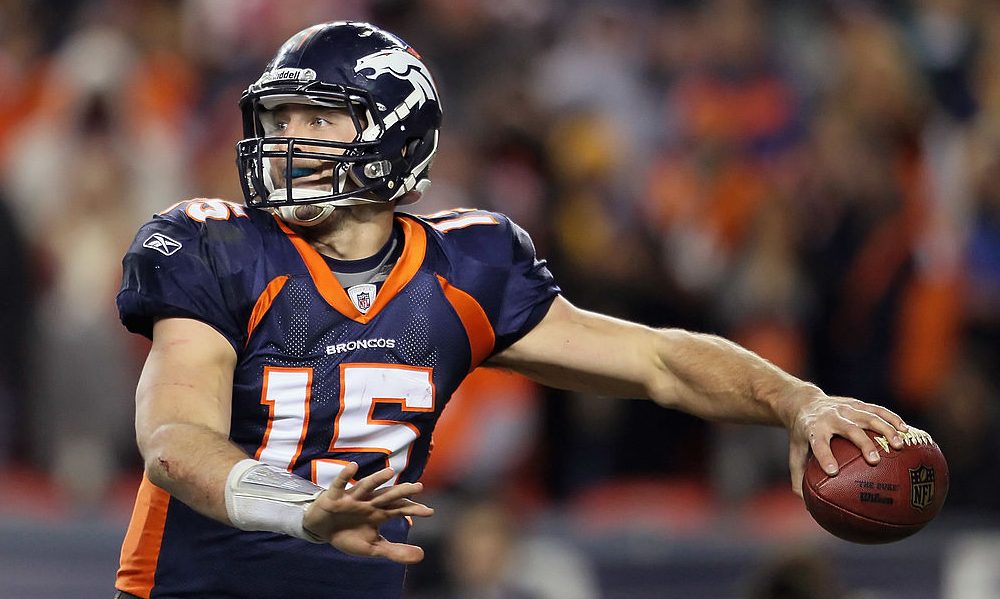
On April 22, 2010, the Denver Broncos selected Tim Tebow with 25th overall pick in the NFL Draft. Tim, 22 at the time, had just come off one of the most successful careers in NCAA history. As part of Urban Meyer’s Florida Gators football team, Tim lead the Gators to two BCS National Championships. He became the first ever sophomore to win the Heisman Trophy award in 2007. He finished his career holding five NCAA records, 14 SEC records, and 28 school records. His NFL career was anything but.
In three seasons, Tebow started 14 games for the Broncos and two for the Jets. He failed to complete 50% of his passes after completing 66.4% in college. He threw nine picks. His best QBR rating was his rookie year when he finished with a 58.6. The worst quarterback in the NFL this past season had a QBR of 85.9. Tebow wasn’t just bad in the NFL. He was brutal. To some, it was a surprise. For many, it was not. Tebow had a glaring issue.
It was only a matter of time – or, in this case, a fraction of time – before it got exposed.
At 6’3 255 lbs., Tebow wasn’t built like your average quarterback. It wouldn’t take much to confuse him for a linebacker. He threw from the left side. His legs helped him as much as his arm did. While he possessed a strong set of intangibles, scouts were skeptical about whether his abilities would transfer to the next level. A big reason behind this was how he released the football.
At the NFL level, quarterbacks do not have the luxury of time. From the time the ball is snapped, they have less than three seconds to make a decision on what to do with the ball. Within this time, quarterbacks are processing the coverage, diagnosing pressure, going through their reads, and figuring out which option is going to be their best one. Once they make a decision on where to go with the ball, the only time left is how long it takes to get the ball out of their hand. This is where Tebow struggled.
The average NFL quarterback takes about 0.4 seconds to release the football. This clock starts once they begin their throwing motion and ends when the ball has left their hand. For perspective, a 90 mph fastball takes about 0.4 seconds to cross home plate from the pitchers hand. It’s also the same amount of time it takes to blink. Tebow’s release took about 0.6 seconds.
While 0.2 seconds seems minuscule, it makes a difference. In 2021, Josh Allen of the Buffalo Bills averaged about 2.4 seconds in pocket time – on par with Chiefs QB Patrick Mahomes and Bengals QB Joe Burrow. If you added 0.2 seconds to Allen’s pocket time, he would be tied for worst out of all NFL starting quarterbacks. 0.2 seconds isn’t just important. It’s critical. Knowing this information, the Broncos still decided to take a waiver on Tebow in the first round. Attempts were made to reform his throwing motion, but none made a significant difference.
From the perspective of a scout, Tebow’s short stint in the NFL is a great lesson of foresight. We can’t evaluate players based on current performance. We need to determine if they’re going to continue to perform at the next level. This process is one of the most difficult jobs in all of sports. There are tons of layers – makeup, work ethic, size, speed, power – that determine how a player will measure up against better competition. Being able to honestly evaluate a player’s current skill set gives you a starting point. Some skills might transfer right away to better competition. Others need time to refine.
That is, if you actually refine them.
The issues scouts saw with Tebow were a legitimate concern. The more time it takes for us to throw, the less time we have to make decisions on where to throw. When you’re playing in the NFL, everyone is fast. Linebackers can cover running backs. 300 lb. defensive linemen run sub 4.8 40’s. The average play takes less than three seconds to unfold. You simply cannot afford to waste time – especially if you’re the guy in charge of running the show. Time is a premium.
It’s even more important in a sport where decisions are made in the blink of an eye.
…
If you ask 10 different hitters what’s most important to them, you’re going to get 10 slightly different answers. Of those answers, there’s often one that sticks out among the rest: Timing. If you spend enough time around hitters, you’ll find out pretty quickly just how important it is to guys. When hitters are at their best, they feel in control of their time. This would seem to make sense. You arguably won’t find a more time pressured task in all of sports. In roughly 0.250 seconds, hitters have to be able to dissect pitch type, location, and whether they’re going to swing or not. The other .150 seconds are reserved for the actual swing.
If you thought 0.2 seconds wasn’t much, just imagine an activity where a miscalculation of 0.075 seconds can be the difference between success and failure. You have zero room for error.
While hitting is considered the “offensive” portion of the game, Donnie Ecker – bench coach and hitting coordinator Texas Rangers – argues the opposite. Hitters are not playing offense. They’re playing defense. Hitting is an open skill, meaning our actions are dependent on an external stimulus (i.e. the pitcher). We don’t just swing. We swing in response to what the pitcher throws at us. Hitters are not calling the shots. Pitchers are. Hitters are simply making the best decisions they can using the information they have at their disposal. It’s a lot easier to make better decisions when we have more time to make them.
As seen in Tebow’s situation, the single biggest thing that eliminates most hitters is time. When pitchers start throwing harder, hitters have to start making decisions using less time at their disposal. This creates a constraint of action. The less time we have, the more difficult it is to make quality swing decisions. When our decision making suffers, our bat to ball goes with it. Great hitters, as a result, find ways to buy themselves time. For most guys, the lowest hanging fruit is the swing itself.
While great hitters all have unique signatures, they share similar key characteristics. These characteristics are born out of necessity. If we know we have a fraction of time to get our swing off, we can’t afford to waste time. Everything we do in the swing must save us time.
To think about this, let’s consider the following swing flaws:
- Shifting at the hips
- Disconnected barrel (casting)
- Over rotating
What’s the common theme behind all of these? They suck up precious time.
When the hips shift after foot plant, we’re late to stop and rotate. This costs us time. The head continues to move forward when it needs to stabilize. This makes everything get on us a lot quicker. When the barrel casts and gets disconnected, it creates a really long arc to the ball. This makes it tough to have a quick time to contact. The barrel arrives late to the party. When you over rotate, you’re not making tight moves through small windows of space. You’re making big moves through a big window of space. This is a time killer.
Here’s the thing: You don’t really know how much time you need until you run out of it. Tim Tebow had a ton of success with his longer release arc at Florida. He didn’t see the repercussions of this until it became a detriment to his success at the NFL level. People don’t change until they have to. From a development perspective, this creates a difficult situation. We want our players to have success, but we can’t get married to that success if we know it’s not going to translate against better competition. If it’s not going to, we have to make a change – even when it’s the unpopular thing to do.
Especially when it’s the unpopular thing to do.
…
As coaches, we can’t focus own building skills that only work right now. We need to build skills that scale. The game will always tell you if it’s working or not. We need to address this before it becomes the problem – not after it’s a problem.
Baseball is littered with examples of players that have made subtle swing changes since first entering the league. Huge moves get smaller. Big leg kicks turn into subtle leg kicks. More rotating turns into less rotating. Moves that worked against slower pitching don’t quite cut it against better pitching. Time is the measuring stick. If you can’t get your swing off in time, you don’t have a swing that works. If you don’t find one that does, you’ll wind up like Tebow.
The game is an honest evaluator. It’ll tell you everything you need to know – whether you want to hear it or not.
If you’re a coach and you work with hitters, get your kids to dress for the job they want – not the one they currently have. If you think you have something that works, don’t just continue to hammer flips. Challenge it. Expose it to velocity. See where it breaks down. There’s a big difference between a swing that looks good and a swing that performs good. We shouldn’t be concerned with aesthetics. We should be concerned with performance. The best way to test for this is to challenge it in environments that replicate performance conditions. It’s either going to work or it’s not.
If you’re working with any guys struggling to buy time, I’d probably ask these three questions:
- How do they get themselves in a position to hit?
- What does the barrel do when it is time to hit?
- If the barrel is tardy, who is at fault: The bat, or the body?
Your answer probably lies in one of those three questions.
Coach accordingly.
